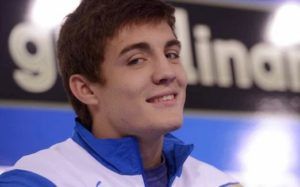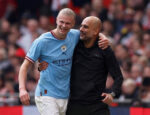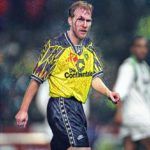One in a million talent, you say? Try one in five million (approximately Croatia’s population) talent, and you would still be far from the truth. Since the golden era of Croatian football in the late ’90s and the likes of Šuker and Prosinečki, there wasn’t a player who could entertain fans and produce spectacle at such a young age, as Kovačić does.
Although Dinamo was heavily beaten again in his 2 consecutive Champions league runs with the club, scouts from all over the world would leave the stadium having written the very same name in their pocket books – Mateo Kovačić.
But to start from the beginning..Kovačić was born and raised in Austria, where he was a „wunderkind“ at Lask Linz side. When he was 13, several clubs made it clear they were interested in him, including Juventus and Ajax, but his family opted for their homeland so Kovačić joined Dinamo Zagreb, the country’s most successful and popular club. Although his talent was apparent and he was easing through the Dinamo’s age groups playing with older kids, he was seriously injured in 2009 (broken leg). Such a horrifying injury is very dangerous for one’s career, especially at that age, but Mateo didn’t despair.
Through his well known work ethic and belief in God (even more than in his football capacity), he fought back hard and his talent recognized pretty soon. Back in 2010, the club’s manager wasVahid Halilhodžić,a g former Bosnian striker who recently managed to qualify for the 2014 World cup with the Algerian side. He was the first to give Mateo a chance in the first team, as Mateo scored on his debut against Dragovoljac, becoming the club’s youngest debutant and goalscorer, as well as the youngest goalscorer in the Croatian’s first division history (both of the records will eventually be redefined by new youngsters from Dinamo – Brodić and Halilović, respectively).
His rise to the stars was inevitable – after 7 games and one goal in his debut season (Dinamo was crowned a champion, again), he would go on and become club’s top player, helping the team to another title (7th consecutive) and qualifiying for their first Champions league run in 13 years). It wasn’t a great experience for Dinamo fans, but it was a revelation to international football stage. At the age of 17, he was named as the youngest captain in the club’s history .
There was this guy, 17-18 year old midfielder with no apparent physical power, but he would go and dribble past 3 or 4 opponents before someone could stop his run by fouling him. His passing was sublime, his football IQ off the charts and he was already capable to take on the likes of Xabi Alonso or Gonalons. No respect, no fear – he would just take the ball and go around his opponents like they were cones on the training ground. In the last game of the group stage, he managed to give Dinamo lead against Lyon in their biggest defeat of the campaign (1-7).
The world was starting to see what Zagreb audience had already knew – Kovačić was big time. It came as somewhat of a suprise when national team manager at the time, Slaven Bilić, didn’t select him in his squad for the 2012 Euro, but it wasn’t something that had a real impact on this tough boy. He continued to impress fans, coaching staff and international scouting community. Dinamo qualified for the Champions league again, and Kovačić was there to play every single one of of 6 games in the group stage. He was recognized as one of 40 greatest youngster (Golden boy award)in the world by Italian Tuttosport magazine (Isco would go on to win it).
It was starting to look like there would be something out of a team that was starting to build around him , but on January 31, 2013. those dreams were ruined.
Internazionale were the first heavy-weight team that met the financial standards and paid 13 milion euros to bring his talent to Milan. It was seen as embarrassinlgy small fee to pay for Dinamo supporters, and Mateo was forced to leave his beloved club. What kind of respect he had for Dinamo jersey? Here’s a story for every football romantic in the world – back in his days as a Dinamo u-15 captain, they were playing a friendly game in Slovenia. One of the Slovenians fouled and injured one of Dinamo’s players very hard, and suddenly – a rumble broke out. But before Kovačić was there defending his teammate, he took off his jersey. When asked afterwards why he did it, his response was : „It would be completely inappropriate to go into a fight with sacred jersey still on me.“
All in all, he played 73 games and scored 8 goals for the club, dishing many assists along the way.
It didn’t take long before the Italians realized what kind of diamond they’ve purchased. His debut came 2 weeks after that, and his first real impact was a great assist for Palacio in the Europa league fixture against Cluj. His importance was raising on a weekly basis as he was making the most out of the opportunities that came his way. Andrea Strammacioni soon made him first-team regular placing him in the heart of the midfield, in a role that was something like „regista“, as Italians like to call it. Regista is a player that dictates the play of the game, shifts ball from one wing to another. What Pirlo was doing at Juve with his incredibly accurate long balls, Kovačić was doing by taking the ball and penetrating through oposition’s lines, making them shift again and again. His run against Juve across the pitch leaving 5 defenders behind is probably the single most memorable moment of his career at Inter.
And as for the national team, he was a regular at every age group, and his senior debut couldn’t had been more dramatic – he was placed alongside Luka Modrić in the midfield against arch rivals- Serbia. Mateo played excellent game , making the difference in the middle of the pitch (Croatia won 2-0 with him at a DM position, although his defensive progress is not near close to finish), and many pundits, as well as his teammate Kranjčar, said he played „like a proffesor“. The nickname stuck, and pretty soon, Inter’s Curva Nord started to call this genius simply „Il professore“. Last season, he was recognized as Europe’s second best dribbler, only behind Ribery (by OPTA).
His international team followed his progress at a club stage, as he became an indispensable member of the squad. Most recent memory is that of a World cup playoff against Iceland, where he would make his signature move(s), creating chaos in Iceland defence before dishing assist to Srna who would score to ensure Croatia were through.
This season, Mazzarri took helm at the club, and he is still to determine where exactly he sees Kovačić. He would often use him as a winger who would cut inside and to overload in the midfield, as he tends to give central roles to more experienced players.
Author of this text doesn’t have much to brag about – it doesn’t take any special football intelligence to see just how good Kovačić is. But exactly because of that, he deserves to find his place among this superstars, before he reaches the next level – maybe he will in Brazil this summer. Those of you who aren’t familiar with „Il proffesore“- shame on you. But now you know, and believe me – this kid is something special. Allow yourself to be amazed by his green pitch rhapsody.










Recent Comments